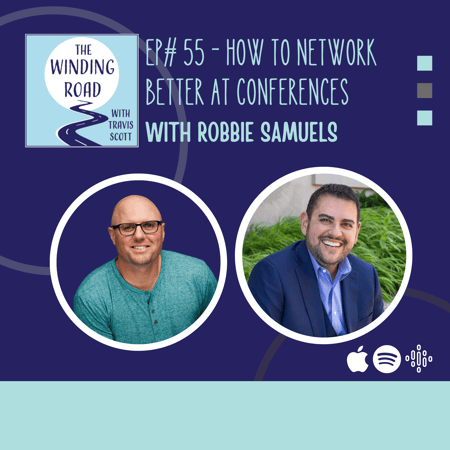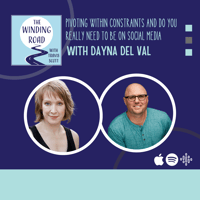I’m finally doing something I’ve wanted to do for a while now: sit down and write.
Robbie Samuels: How to Become Better at Networking During Conferences and Tradeshows

Networking at conferences can be intimidating and many of us return home feeling like we left opportunities on the table.
In person conferences and tradeshows have been back in full swing for over a year now but the same problem we have before the pandemic still exists: how can we become better at networking while we're there?
Robbie Samuels, the author of Croissants vs Bagels: Strategic , Effective, & Inclusive Networking at Conferences, joined me on the Winding Road Careers podcast to talk about how to become better at this very thing.
Reasons It Doesn't Work
We register for an upcoming conference or tradeshow and are excited about the lineup of speakers and the breakouts. We're also excited about the people we're going to meet and what that could mean for our career.
Then, we return from the conference feeling like we failed to meet the people we wanted to. There are several reasons for this; maybe we're shy, we didn't prepare well enough, the event was poorly structured or a combination of these things.
Regardless, we feel like we could have done more.
Over the course of the interview, Robbie laid out several strategies for making better connections, especially if our goal is to build business relationships that could turn into future sales.
Write Your Follow Up Email Before You Go
According to Robbie, one of the best ways to prepare for an upcoming conference or tradeshow is to create your email follow templates before you go.
This has several benefits including helping you think through who you want to meet and how those conversations might go. There's something powerful about visualizing events before they happen. When you have the conversations at the show, it will feel like it's already happened before and will take away some of the anxiousness you might feel about approaching people.
It will also help you be more focused on what you want to talk about.
If you do this, be sure to set aside time at the show to send out your follow up. This will save you time when you're back in the office and might impress the person you just met since most of the people they met at the show will email them when they're back at their desks.
Change Your Lens
For many people attending a tradeshow, their sales managers will be demanding that they come back with a ginormous list of 'leads' that they can try to bang their heads against a wall trying to sell a complex solution to a problem they didn't think they had after its over.
This is the worst approach you could take.
Instead, change the lens you're viewing the event through. If you approach it as a way to gather market research and sow the seeds of a long-term relationship you might be surprised at the outcome.
Later, I talk about focusing on their "little P" problems. That will be the key insight you need to eventually help them with their more complex problems that will really move the needle, but also require a substantial investment.
How to Approach People at a Tradeshow Booth
If you're attending a tradeshow to do "counter flyering," that is, you don't have a booth because your target audience are the ones with the booths, then you know how it can be awkward walking up to someone who isn't necessarily there to learn about your solution to their problems. They're there to sell and come back with a list of leads to show off to their sales manager.
Instead of focusing on yourself and the big problems your company solves, start the conversation asking them what their company does, how the show has been, and then dig into what some of the challenges they're running into. You might uncover this when you ask how the show is going, if they say "not as well as we expected" or "it's been slow." Then you can dig into why that might be.
Answering the Dreaded "What Do You Do?" Question
Invariably, you're going to be asked "what do you do?" and our first instinct is to blurt out our job title, the company we work for and some long-winded diatribe about the complex problems we solve with a lot of industry jargon and acronyms they don't understand thrown in.
Instead, Robbie says to answer with "I help [blank] do [blank] so they can [blank]." Don't share the 'how' or process of what we do.
If you start with who you help - the very specific who, not something broad like entrepreneurs - what you help them with and, most importantly, why that's important, you'll give them the chance to self-identify if they should be included in the group you just described.
The 'why' is really important because that is going to demonstrate the value of what you do and, at the end of the day, if you're not providing value, what are you providing?
Focus on "Little P" Problems
As I've mentioned, we go into a conference hoping to tell people about the big hairy problems we help them solve. Most of the time, the people we'll engage with at a conference or a tradeshow, won't recognize the problem you're describing. They're either "inside the jar and can't read the label," as I've heard David C. Baker describe it, or they're preoccupied with smaller problems - the "little P's".
Focus on the "Little P's" first, because often they could be a symptom of the larger problem they might have that your company is uniquely positioned to solve for them.
Organize a Meetup or Dinner Ahead of the Event
Another way to break the ice, start to build relationships, and become a connector that's bringing people together, is to host a meetup, happy hour, or dinner during the event.
People will appreciate an invite, especially if it's during an evening or afternoon where there isn't anything formally planned through the event. They'll also be grateful that you helped them meet other people and made the process of networking easier for them.
Bonus: People First Design and Robbie's Next Book
Although Robbie and I were mostly discussing his first book, Croissants vs Bagels, he was putting the finishing touches on his latest book that came out March 13th of this year (2023) called Break Out of Boredom: Low Tech Solutions for Highly Engaging Zoom Events. We talked about his new book, why he decided to write it, which lead us to talk about a fascinating topic called "people first design." This principle is not only helpful when planning events, but can be an effective way to think about sales and marketing campaigns or just about anything you do that will touch a customer or prospective customer.
It essentially, helps you tell a better story that connects at a deeper level with your audience - it's all about the transformation you want people to have after they've interacted with your content or event.
Are you looking for a job and feel like you need some guidance? I offer new way of coaching using asynchronous voice messaging. If you'd like to tap into my experience of being a former recruiter along with my deep understanding of marketing careers, consider my 6- week coaching program.
-1.png?width=500&height=125&name=Website%20Logo%20-%20400x100%20(transparent%20background)-1.png)


